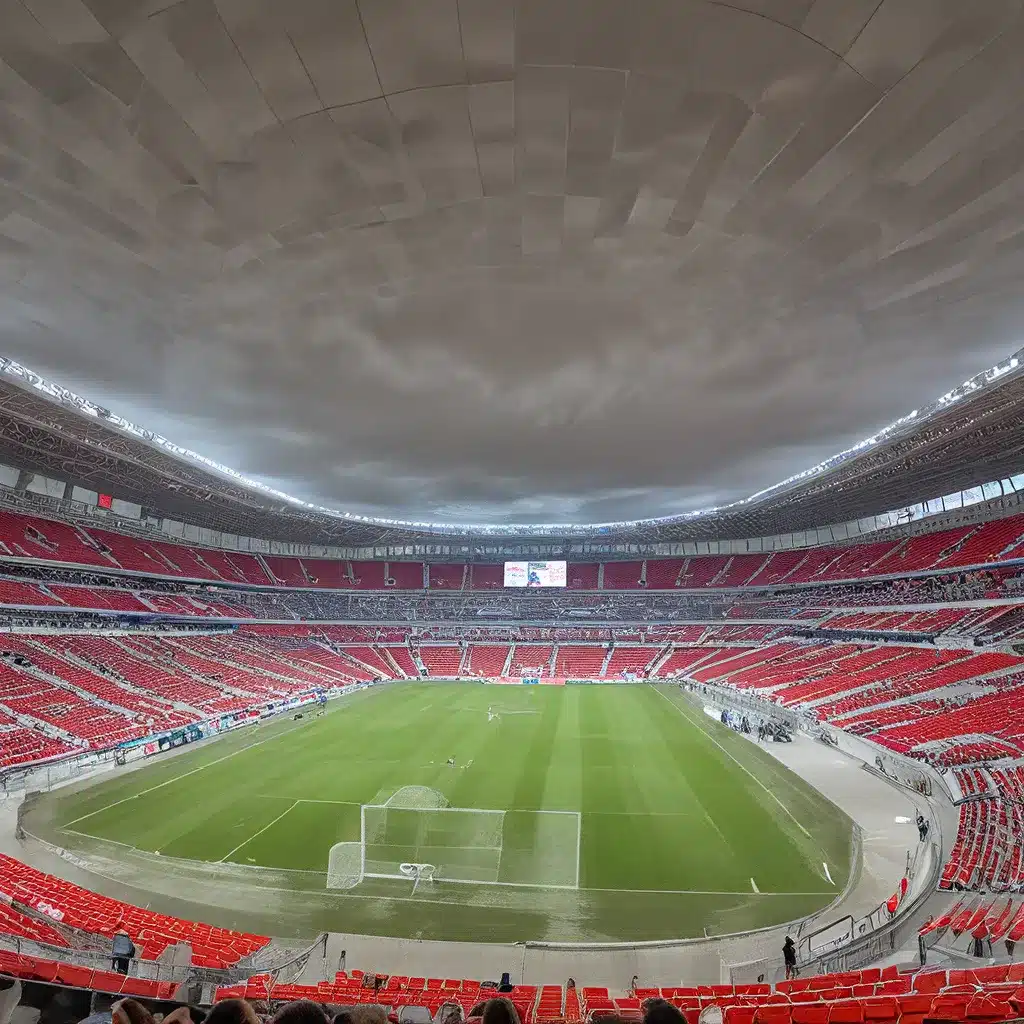
The Pinnacle of Modern Stadium Design
The Allianz Arena in Munich, Germany, stands as a true masterpiece of modern architecture and a testament to the region’s rich cultural and sporting heritage. Opened in 2005, this iconic football stadium has captivated the world with its distinctive exterior, innovative features, and commitment to environmental sustainability.
Designed by the renowned architecture firm Herzog & de Meuron, the Allianz Arena is celebrated for its unique facade, which is composed of over 2,800 ETFE plastic panels that can be illuminated in a variety of colors. This feature allows the stadium to change its appearance to reflect the home team’s colors – red for FC Bayern Munich, blue for TSV 1860 Munich, and white for the German national team. The stadium’s exterior, often referred to as a “bubble” or “inflatable boat,” is not only an aesthetic triumph but also a functional one, as the ETFE panels are highly durable, self-cleaning, and allow natural light to filter through, reducing the need for artificial lighting during the day.
The Allianz Arena’s design incorporates several innovative features aimed at enhancing the fan experience. The stadium boasts excellent sightlines from all seats, ensuring that every spectator has a clear view of the action on the pitch. Additionally, the acoustics have been meticulously engineered to amplify the crowd’s roar, creating an electrifying atmosphere during matches. Another notable feature is the arena’s flexibility, as it was originally designed to accommodate both football and American football, with retractable seating areas and modular sections that can be adapted for different types of events, making it a versatile venue for concerts and other large-scale gatherings.
Sustainability at the Forefront
Sustainability is a core principle in the design and operation of the Allianz Arena. The stadium employs a range of eco-friendly technologies, including a rainwater collection system that captures and recycles water for pitch irrigation and sanitary facilities. Solar panels installed on the arena’s roof generate renewable energy, while advanced waste management and recycling programs ensure minimal environmental impact. Moreover, the Allianz Arena is well-integrated into Munich’s public transportation network, encouraging fans to use eco-friendly modes of transport, such as the nearby Fröttmaning U-Bahn station, which facilitates easy access to the stadium and reduces the carbon footprint associated with matchday travel.
The Allianz Arena’s commitment to sustainability is not only evident in its physical design and operations but also in its broader impact on the community. As a hub for sports, entertainment, and cultural events, the stadium serves as a model for sustainable urban development, showcasing how innovative architecture and eco-friendly practices can be seamlessly integrated to create a truly modern and environmentally conscious venue.
Legacy and Impact
The Allianz Arena’s architectural significance extends beyond its striking appearance and innovative features. As the home of the legendary FC Bayern Munich, the stadium has become an integral part of the city’s cultural and sporting identity, hosting countless memorable matches and events that have cemented its place in the annals of football history.
Beyond its role as a sports venue, the Allianz Arena has also become a destination for architectural enthusiasts and design aficionados from around the world. The stadium’s unique and visually captivating design has earned it a reputation as one of the most iconic and recognizable sports facilities in Europe, attracting visitors who come to marvel at its architectural splendor and immerse themselves in the electrifying atmosphere of a live football match.
The Allianz Arena in Context
While the Allianz Arena is undoubtedly the crown jewel of Munich’s sporting landscape, the city boasts a rich history of legendary stadiums that have contributed to the region’s storied football legacy. One such landmark is the Olympiastadion, built for the 1972 Summer Olympics and renowned for its sweeping tent-like roof structure, which was revolutionary at the time. Designed by Günter Behnisch and Frei Otto, the Olympiastadion’s transparent acrylic glass roof creates a unique visual effect and allows natural light to flood the stadium, which has a capacity of over 69,000 and has hosted numerous historic events, including the 1974 FIFA World Cup Final and the 1988 UEFA European Championship Final.
Another notable stadium in Bavaria is the Max-Morlock-Stadion, home to the 1. FC Nuremberg football club. This stadium, named after the legendary Nuremberg footballer Max Morlock, was built within only two years from 1926 to 1928, a remarkable feat made possible by a cooperation with the local employment office, which provided up to ten thousand unemployed workers from Nuremberg and the surrounding area for earthworks and gardening. The stadium’s octagonal shape and Bauhaus-style architecture have made it a beloved landmark in the region, with parts of the stadium being listed as historical monuments.
Embracing the Future of Stadium Design
As Munich prepares to host several matches during the 2024 UEFA European Football Championship, the spotlight will undoubtedly shine on the Allianz Arena, showcasing its architectural brilliance and sustainable initiatives to a global audience. However, the city’s rich football heritage extends beyond this modern marvel, with other legendary stadiums like the Olympiastadion and Max-Morlock-Stadion serving as reminders of the region’s deep-rooted passion for the sport and its enduring legacy.
In the face of growing environmental concerns and the evolving demands of modern sports, the Allianz Arena stands as a shining example of how stadium design can seamlessly integrate cutting-edge architecture, innovative sustainability practices, and an unparalleled fan experience. As the world continues to explore new frontiers in sports infrastructure, the Allianz Arena’s legacy will undoubtedly inspire and guide future generations of architects, engineers, and sports enthusiasts alike, ensuring that Bavaria remains a true footballing heartland and a hub for architectural excellence.
Explore more legendary stadiums and their unique stories on Old Stadium Journey, your ultimate guide to the world’s most captivating sports venues.

